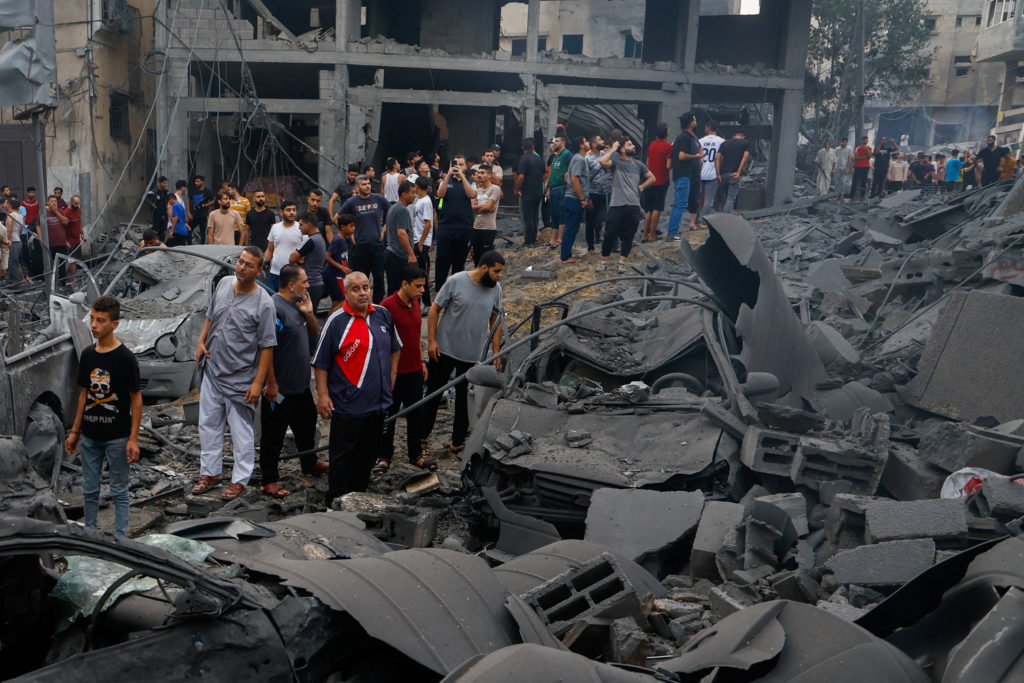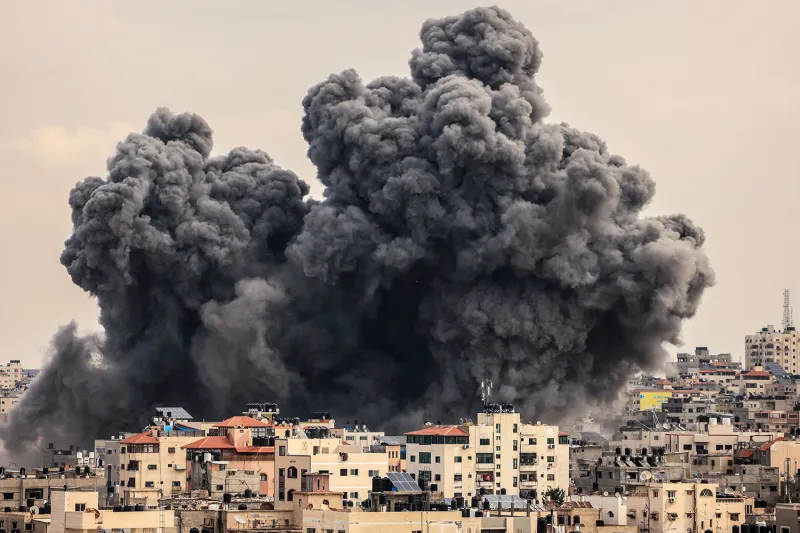 Washinton Post
Washinton Post
Ishaan Tharoor*
11 ottobre 2023
(Alla fine dell’articolo tradotto in italiano c’è il testo originale in inglese)
Sembra imminente un’invasione di terra della Striscia di Gaza, mentre le autorità israeliane intraprendono una campagna per sradicare il gruppo islamista Hamas. Sabato, i militanti della fazione hanno orchestrato il giorno più sanguinoso nei 75 anni di storia del moderno Stato israeliano, irrompendo attraverso il confine fortificato con Israele e compiendo un’orrenda carneficina nei vicini villaggi israeliani e in un affollato festival musicale. Almeno 1.000 persone sono state uccise nella furia, mentre il destino di oltre 100 ostaggi rapiti e portati a Gaza è in bilico.

Martedì, in un breve discorso dalla Casa Bianca, il presidente Joe Biden ha dichiarato che gli Stati Uniti “sono al fianco di Israele”. Ha descritto gli eventi del fine settimana come “pura malvagità” e ha affermato che Israele non ha solo il diritto ma anche il “dovere” di rispondere all’attacco di Hamas con la forza. L’incessante campagna israeliana di attacchi aerei sull’enclave palestinese densamente popolata ha già ucciso almeno 920 palestinesi, con rapporti e immagini provenienti dal territorio di ospedali stracolmi e quartieri rasi al suolo.
In Israele, lo shock dell’attacco ha lasciato il posto a una risoluta determinazione. Si profilano interrogativi sul sorprendente fallimento dell’intelligence che ha preceduto l’assalto di Hamas, nonché sul futuro politico del polarizzante Primo Ministro Benjamin Netanyahu, che non è riuscito a sventare la carneficina. Per ora, però, le autorità danno una dimostrazione di unità. “Prima di porci domande difficili, abbiamo una missione”, ha dichiarato martedì ai giornalisti il generale Dan Goldfuss, che comanda la 98ª Divisione paracadutisti del Paese. “Stiamo passando all’offensiva ora con tutti i tipi di capacità e angolazioni”.
Ha aggiunto che l’obiettivo della campagna israeliana sarà quello di “insegnare all’altra parte che non c’è modo di farlo senza che noi cambiamo la realtà”. È una triste notizia per gli oltre 2 milioni di persone intrappolate nella Striscia di Gaza, di cui circa la metà sono bambini.
La natura senza precedenti di ciò che è accaduto e l’incertezza di ciò che accadrà in seguito hanno portato gli analisti a guardare al passato per trovare qualche precedente. Ecco tre analogie che possono aiutare i lettori a riflettere sull’ampia e tragica portata di quanto sta accadendo.
L’11 settembre di Israele
Il parallelo più immediato emerso sulla scia dell’attacco di Hamas è stato il riferimento l’aggressione di Al-Qaeda agli Stati Uniti dell’11 settembre 2001. Pro capite, in termini di numero di vittime, sabato Israele ha subito diversi 11 settembre. Ma l’analogia sta nello shock e nella sorpresa di ciò che è accaduto, nelle dimensioni della tragedia e nell’irrefrenabile desiderio nazionale di vendetta.
“L’effetto che questo avrà sulla nostra psiche collettiva e sulla nostra coscienza condivisa, sul nostro senso di sicurezza e sulla nostra fiducia nella capacità di vivere liberamente e in sicurezza in questa terra, si farà sentire per decenni, se non per generazioni”, ha scritto Avi Mayer, direttore del Jerusalem Post, che ha salutato questo momento come l’11 settembre di Israele.
L’analogia ha implicazioni preoccupanti: gli Stati Uniti hanno trascorso la maggior parte di due decenni a portare avanti costose guerre al terrorismo, invadendo Paesi e lanciando una rete globale contro gli estremisti islamici. Ma la minaccia dei militanti non è stata eliminata. I talebani sono tornati al potere in Afghanistan e l’Iraq rimane una polveriera geopolitica, in qualche modo allineata al regime teocratico dell’Iran.
Una vittoria israeliana su Hamas difficilmente garantisce una pace duratura. “Anche supponendo che Hamas possa essere distrutto, né Biden né Netanyahu sono in grado di rispondere alle difficili domande su cosa accadrà dopo la punizione di Israele: chi gestirà Gaza e quale sarà lo status dei palestinesi in mezzo a Israele?”, ha osservato Gregg Carlstrom dell’Economist.
Guerra dello Yom Kippur 1973
Fino a questo sabato, nessun giorno nella storia di Israele era stato così traumatico come il 6 ottobre 1973, quando gli eserciti di Egitto e Siria lanciarono un’invasione coordinata e a sorpresa del territorio israeliano nella penisola del Sinai e nelle alture del Golan. Alla fine Israele si riprese e respinse le forze arabe con l’aiuto militare degli Stati Uniti. Le battaglie di allora erano esistenziali: sembrava, anche se per poco, che il nascente Stato israeliano potesse essere spazzato via. Oggi non è più così, data la grande asimmetria di potere tra Israele e le fazioni militanti schierate contro di lui.

Ma le prospettive potrebbero essere ancora più fosche. “La vittoria, anche se definibile, sarà probabilmente di Pirro”, ha scritto l’ex diplomatico israeliano Michael Oren. “La guerra del 1973 ha creato le condizioni per i negoziati tra Egitto e Israele e ha portato, sei anni dopo, agli accordi di Camp David. Ma il presidente egiziano di allora, Anwar Sadat, cercava la pace; i leader di Hamas cercano il genocidio”.
Martedì Biden ha ricordato il suo incontro con l’allora primo ministro Golda Meir, che incontrò da giovane senatore durante un viaggio in Israele avvenuto circa cinque settimane prima dello scoppio della guerra dello Yom Kippur. Ha raccontato che Meir gli confidò che l'”arma segreta” di Israele era che il suo popolo non aveva “nessun altro posto dove andare”.
Questa settimana, la domanda più urgente è dove andranno i 2 milioni di abitanti di Gaza. Martedì scorso, un funzionario israeliano ha dichiarato al canale 13 del Paese che Gaza sarebbe stata ridotta a “una città di tende”. I valichi di frontiera sono chiusi, per ora, e il bilancio delle vittime è in costante aumento.
Invasione israeliana del Libano nel 1982
Nell’estate del 1982, le truppe israeliane, con il tacito appoggio degli Stati Uniti, entrarono in Libano per eliminare la presenza dell’Organizzazione per la Liberazione della Palestina. Le forze israeliane assediarono addirittura la capitale Beirut per due mesi. Sebbene siano riuscite a cacciare l’OLP dal Libano, l’eredità della “prima guerra di terra su larga scala di Israele contro un’entità non statale”, come ha scritto Kim Ghattas sul Financial Times, è stata quella di un costoso errore strategico.
Le milizie cristiane libanesi di destra alleate degli israeliani compirono orrendi massacri di fino a 2.000 palestinesi nei campi profughi di Sabra e Shatila e di centinaia di civili libanesi. In reazione all’invasione, la Siria e l’Iran formarono un “asse di resistenza” che ancora oggi modella l’equazione geopolitica.
“La lezione degli ultimi quarant’anni è che ogni tentativo di spazzare via i gruppi armati palestinesi ha prodotto solo iterazioni più estreme e peggiori enigmi”, ha scritto Ghattas. “Due giorni dopo l’invasione del Libano da parte di Israele, un aereo di Guardie rivoluzionarie iraniane è arrivato a Damasco e si è diretto nella Valle della Bekaa in Libano con la benedizione del presidente siriano Hafez al-Assad. Da quando l’Iran è arrivato nel Levante, non se n’è più andato”.
Ghattas ha concluso: “Il pericolo ora è quello di altri errori strategici che non faranno altro che perpetuare la violenza per gli anni a venire”.
Ishaan Tharoor
*Ishaan Tharoor è un editorialista di affari esteri del Washington Post, dove è autore della newsletter e della rubrica Today’s WorldView. Nel 2021 ha vinto l’Arthur Ross Media Award in Commentary dell’American Academy of Diplomacy. In precedenza è stato redattore senior e corrispondente della rivista Time, prima a Hong Kong e poi a New York.
The troubling analogies surrounding the new Israel-Hamas war
 Washington Post
Washington Post
*Ishaan Tharoor
11 october 2023
A ground invasion of the Gaza Strip appears imminent, as Israeli authorities embark on a campaign to root out Islamist group Hamas. On Saturday, the faction’s militants orchestrated the single bloodiest day in the 75-year history of the modern Israeli state, bursting across the fortified border with Israel and carrying out a hideous killing spree in nearby Israeli villages and at a crowded music festival. At least 1,000 people were killed in the rampage, while the fate of more than 100 hostages abducted and taken to Gaza hangs in the balance.
In a short speech from the White House on Tuesday, President Biden declared that the United States “stands with Israel.” He described the events of the weekend as “pure unadulterated evil” and said that Israel had not just a right but a “duty” to respond to Hamas’s attack with force. Already, a relentless Israeli campaign of airstrikes on the densely populated Palestinian enclave has killed at least 920 Palestinians, with reports and images coming out from the territory of overflowing hospitals and neighborhoods flattened.
In Israel, the shock of the strike has given way to a steely resolve. Questions loom over the astonishing intelligence failure that preceded Hamas’s assault, as well as the political future of polarizing Prime Minister Benjamin Netanyahu, who failed to thwart the carnage. For now, though, authorities are projecting a show of unity. “Before we go and ask ourselves tough questions, we have a mission,” Gen. Dan Goldfuss, who commands the country’s 98th Paratroopers Division, told reporters Tuesday. “We are moving into the offensive now with all kinds of capabilities and angles.”
He added that the goal of the Israeli campaign would be to “teach the other side that there is no way that they can do this without us changing the reality.” That’s grim tidings for the more than 2 million people trapped within the Gaza Strip, roughly half of whom are children.
The unprecedented nature of what’s taken place and the uncertainty of what comes next has led to analysts reaching back into the past for some precedent. Here are three analogies that may help readers think through the broad, tragic sweep of what’s in motion.
‘Israel’s 9/11’
The most immediate parallel that emerged in the wake of Hamas’s attack was reference to the al-Qaeda strike on the United States on Sept. 11, 2001. Per capita, in terms of the death toll, Israel suffered multiple 9/11s on Saturday. But the analogy lies in the shock and surprise of what happened, in the scale of the tragedy, and in the overwhelming national desire for retribution. “The effect this will have on our collective psyche and our shared consciousness, on our very sense of security and our confidence in our ability to live freely and securely in this land — it will be felt for decades if not generations,” wrote Avi Mayer, editor in chief of the Jerusalem Post who hailed the moment as Israel’s 9/11.
The analogy carries some worrying implications: The United States spent the better part of two decades prosecuting costly wars on terror, invading countries and casting a global dragnet against Islamist extremists. But the Islamist militant threat has not been expunged. The Taliban is back in power in Afghanistan and Iraq remains a geopolitical powder keg, somewhat aligned to Iran’s theocratic regime.
An Israeli victory over Hamas hardly guarantees a lasting peace. “Even assuming Hamas can be destroyed, neither Biden nor Netanyahu can answer the hard questions about what happens after Israel’s retribution: who will run Gaza, and what will be the status of the Palestinians in Israel’s midst?” noted the Economist’s Gregg Carlstrom.
1973 Yom Kippur War
Until this Saturday, no day in Israeli history had been as uniquely traumatic as Oct. 6, 1973, when the armies of Egypt and Syria launched a coordinated surprise invasion of Israeli territory in the Sinai Peninsula and Golan Heights. Israel eventually recovered its footing and pushed back the Arab forces with U.S. military aid. The battles then were existential — it seemed, if briefly, that the fledgling Israeli state could be snuffed out. That’s less the case today, given the vast asymmetry of power between Israel and the militant factions arrayed against it.
But the outlook may be all the more bleak. “Victory, even if definable, will likely be Pyrrhic,” wrote former Israeli diplomat Michael Oren. “The 1973 war created the conditions for negotiations between Egypt and Israel and led, six years later, to the Camp David Accords. But Egypt’s president at the time, Anwar Sadat, sought peace; Hamas’s leaders seek genocide.”
On Tuesday, Biden recalled his encounter with then-prime minister Golda Meir, whom he met as a young senator on a trip to Israel that took place some five weeks before the breakout of the Yom Kippur War. He said that Meir confided in him that Israel’s “secret weapon” was that its people had “nowhere else to go.”
This week, the more urgent question is where will Gaza’s 2 million people go. On Tuesday, an Israeli official told the country’s Channel 13 that Gaza would be reduced to “a city of tents.” The border crossings are shut, for now, and the death toll is steadily rising.
1982 Israeli invasion of Lebanon
In the summer of 1982, Israeli troops, with tacit U.S. backing, entered Lebanon to eliminate the presence there of the Palestine Liberation Organization. Israel’s forces even besieged the capital Beirut for two months. While they succeeded in driving the PLO out of Lebanon, the legacy of “Israel’s first large-scale ground war against a non-state entity,” as Kim Ghattas wrote in the Financial Times, was that of a costly strategic blunder.
Right-wing Lebanese Christian militias allied to the Israelis carried out the hideous massacres of up to 2,000 Palestinians at the Sabra and Shatila refugee camps, as well as hundreds of Lebanese civilians. In reaction to the invasion, Syria and Iran forged an “axis of resistance” that shapes the geopolitical equation to this day.
“The lesson of the past four decades is also that every attempt to wipe out Palestinian armed groups has only produced more extreme iterations and worse conundrums,” Ghattas wrote. “Two days after Israel’s invasion of Lebanon, a planeload of Iranian Revolutionary Guards arrived in Damascus and headed to Lebanon’s Bekaa Valley with Syrian president Hafez al-Assad’s blessing. Since Iran arrived in the Levant, it has never left.”
Ghattas concluded: “The danger now is of more strategic blunders that will only perpetuate the violence for years to come.”
Ishaan Tharoor*
*Ishaan Tharoor is a foreign affairs columnist at The Washington Post, where he authors the Today’s WorldView newsletter and column. In 2021, he won the Arthur Ross Media Award in Commentary from the American Academy of Diplomacy. He previously was a senior editor and correspondent at Time magazine, based first in Hong Kong and later in New York
